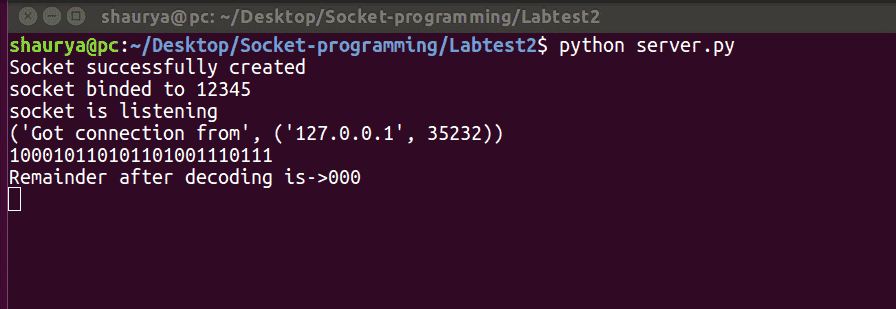什么是CRC? CRC或循环冗余校验是一种检测通信信道中意外变化/错误的方法。 CRC使用在发送方和接收方都可用的生成器多项式。示例生成器多项式的形式为x^3+1。该生成器多项式表示键1001。另一个例子是x^2+x,代表键110。
例子: 让数据发送是“EVN” 我们将字符串转换为二进制字符串数据。
python
input_string = "EVN" # CONVERT string data to binary string data data = (' '.join(format(ord(x), ' b') for x in input_string)) print (data) |
100010110101101001110
CRC密钥:1001 代码:CRC密钥长度-1->000追加在数据末尾。
New data: 100010110101101001110000Key:1001
现在,我们在套接字编程python的发送方和接收方都应用了CRC。
发送方
1.任务是向服务器/接收方发送字符串数据。 2.发送方发送一个字符串,让我们说“EVN”。 3.首先,将该字符串转换为二进制字符串“1000101101101001110”。发送方和接收方都知道密钥,此处使用的密钥为1001。 4.使用客户端/发送方的密钥,使用CRC代码对该数据进行编码。 5.该编码数据被发送到接收器。 6.接收器随后对编码的数据字符串进行解码,以验证是否存在任何错误。
Python3
# Import socket module import socket def xor(a, b): # initialize result result = [] # Traverse all bits, if bits are # same, then XOR is 0, else 1 for i in range ( 1 , len (b)): if a[i] = = b[i]: result.append( '0' ) else : result.append( '1' ) return ''.join(result) # Performs Modulo-2 division def mod2div(divident, divisor): # Number of bits to be XORed at a time. pick = len (divisor) # Slicing the divident to appropriate # length for particular step tmp = divident[ 0 : pick] while pick < len (divident): if tmp[ 0 ] = = '1' : # replace the divident by the result # of XOR and pull 1 bit down tmp = xor(divisor, tmp) + divident[pick] else : # If leftmost bit is '0' # If the leftmost bit of the dividend (or the # part used in each step) is 0, the step cannot # use the regular divisor; we need to use an # all-0s divisor. tmp = xor( '0' * pick, tmp) + divident[pick] # increment pick to move further pick + = 1 # For the last n bits, we have to carry it out # normally as increased value of pick will cause # Index Out of Bounds. if tmp[ 0 ] = = '1' : tmp = xor(divisor, tmp) else : tmp = xor( '0' * pick, tmp) checkword = tmp return checkword # Function used at the sender side to encode # data by appending remainder of modular division # at the end of data. def encodeData(data, key): l_key = len (key) # Appends n-1 zeroes at end of data appended_data = data + '0' * (l_key - 1 ) remainder = mod2div(appended_data, key) # Append remainder in the original data codeword = data + remainder return codeword # Create a socket object s = socket.socket() # Define the port on which you want to connect port = 12345 # connect to the server on local computer s.connect(( '127.0.0.1' , port)) # Send data to server 'Hello world' ## s.sendall('Hello World') input_string = input ( "Enter data you want to send->" ) #s.sendall(input_string) data = (' '.join(format(ord(x), ' b') for x in input_string)) print ( "Entered data in binary format :" ,data) key = "1001" ans = encodeData(data,key) print ( "Encoded data to be sent to server in binary format :" ,ans) s.sendto(ans.encode(),( '127.0.0.1' , 12345 )) # receive data from the server print ( "Received feedback from server :" ,s.recv( 1024 ).decode()) # close the connection s.close() |
![图片[1]-Python中的循环冗余校验-yiteyi-C++库](https://www.yiteyi.com/wp-content/uploads/geeks/geeks_rough2-1.png)
接收端
1.接收方从发送方接收编码数据字符串。 2.接收器在钥匙的帮助下解码数据并找出剩余部分。 3.如果余数为零,则表示发送方发送给接收方的数据没有错误。 4.如果余数为非零,则表示存在错误,将向发送方发送否定确认。然后发送方重新发送数据,直到接收方收到正确的数据。
Python3
# First of all import the socket library import socket def xor(a, b): # initialize result result = [] # Traverse all bits, if bits are # same, then XOR is 0, else 1 for i in range ( 1 , len (b)): if a[i] = = b[i]: result.append( '0' ) else : result.append( '1' ) return ''.join(result) # Performs Modulo-2 division def mod2div(divident, divisor): # Number of bits to be XORed at a time. pick = len (divisor) # Slicing the divident to appropriate # length for particular step tmp = divident[ 0 : pick] while pick < len (divident): if tmp[ 0 ] = = '1' : # replace the divident by the result # of XOR and pull 1 bit down tmp = xor(divisor, tmp) + divident[pick] else : # If leftmost bit is '0' # If the leftmost bit of the dividend (or the # part used in each step) is 0, the step cannot # use the regular divisor; we need to use an # all-0s divisor. tmp = xor( '0' * pick, tmp) + divident[pick] # increment pick to move further pick + = 1 # For the last n bits, we have to carry it out # normally as increased value of pick will cause # Index Out of Bounds. if tmp[ 0 ] = = '1' : tmp = xor(divisor, tmp) else : tmp = xor( '0' * pick, tmp) checkword = tmp return checkword # Function used at the receiver side to decode # data received by sender def decodeData(data, key): l_key = len (key) # Appends n-1 zeroes at end of data appended_data = data.decode() + '0' * (l_key - 1 ) remainder = mod2div(appended_data, key) return remainder # Creating Socket s = socket.socket() print ( "Socket successfully created" ) # reserve a port on your computer in our # case it is 12345 but it can be anything port = 12345 s.bind(('', port)) print ( "socket binded to %s" % (port)) # put the socket into listening mode s.listen( 5 ) print ( "socket is listening" ) while True : # Establish connection with client. c, addr = s.accept() print ( 'Got connection from' , addr) # Get data from client data = c.recv( 1024 ) print ( "Received encoded data in binary format :" , data.decode()) if not data: break key = "1001" ans = decodeData(data, key) print ( "Remainder after decoding is->" + ans) # If remainder is all zeros then no error occured temp = "0" * ( len (key) - 1 ) if ans = = temp: c.sendto(( "THANK you Data ->" + data.decode() + " Received No error FOUND" ).encode(), ( '127.0.0.1' , 12345 )) else : c.sendto(( "Error in data" ).encode(), ( '127.0.0.1' , 12345 )) c.close() |

注: 如何运行该程序: 1.你应该有一个套接字编程库。
2.首先运行服务器程序,然后运行客户端程序。
3.复制粘贴代码时可能会出现缩进错误,因此复制时要小心。
4.您将在拆分终端中看到以下输出。
![图片[3]-Python中的循环冗余校验-yiteyi-C++库](https://www.yiteyi.com/wp-content/uploads/geeks/20210912/geeks_CRC-660x419.png)


![关于”PostgreSQL错误:关系[表]不存在“问题的原因和解决方案-yiteyi-C++库](https://www.yiteyi.com/wp-content/themes/zibll/img/thumbnail.svg)





